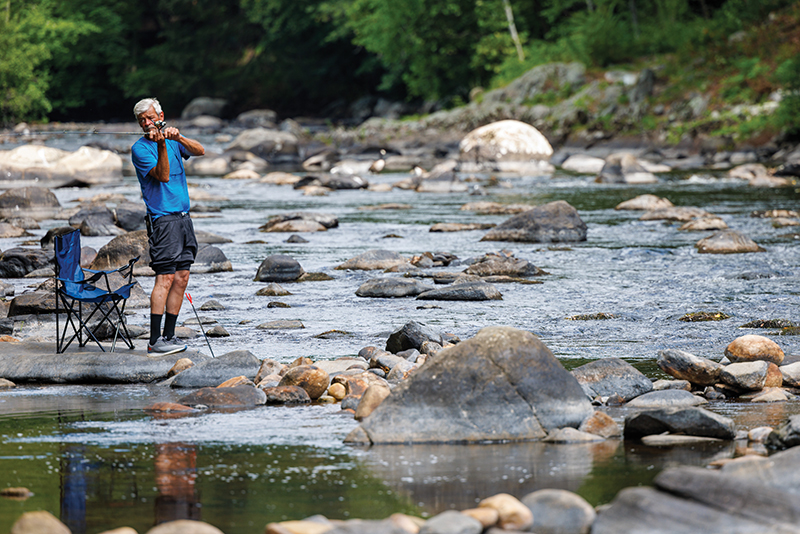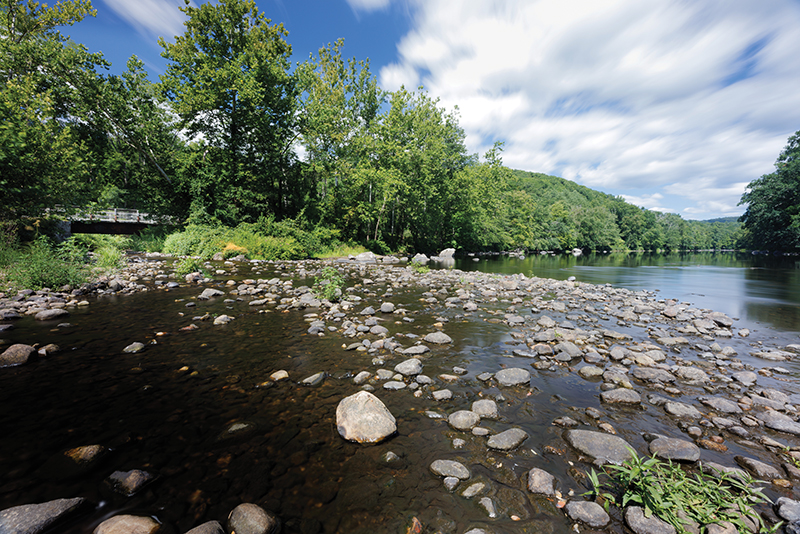
Burlington Brook flows under a pedestrian bridge and joins the Farmington River at a spot popular for recreation along the Farmington Canal Heritage Trail in Burlington, CT. This area was designated a no fishing zone as it provided a thermal refuge for fish where the cooler waters of the brook merged with the Farmington River. Image Credit: Christopher Zajac.
By Steve Gephard
The tall mountains of the Pacific Northwest usually gather a lot of snow that typically lasts through the summer. The snowmelt provides a reliable source of cool water that descends the rivers, supporting salmon and trout populations. In the Connecticut River watershed, the pattern is different. The Green and White Mountains get snow, but not enough to supply cool water all summer. The Connecticut River freshet typically lasts through May, and summer flows are dependent upon rain. Accordingly, the historic runs of Atlantic salmon occurred in the spring. By July, the streams were too shallow and warm to be hospitable for salmon. At that time, the salmon needed to be already up in the cooler headwater pools to await fall spawning.
This trend also affected other stream fish. The only native trout was the brook trout, which is relatively intolerant of warm water. By summer, brook trout would have retreated upstream or into small, cool tributaries that were fed by groundwater seepage and shaded by a complete tree canopy. While the Connecticut River throughout most of its length has never been a trout stream, most tributaries hosted the species. But because the larger tributaries like the Farmington, Westfield, West, and Ashuelot rivers became warm during the summer, their main channels may not have held large year-round populations of brook trout.
Things have changed along the Farmington River over the years. First, the European brown trout was introduced in the late 1800s, and even though many are stocked, caught by anglers, and removed from the river each year, many others have “naturalized” and there is now a population of wild brown trout in the Farmington River. The brown trout is much more tolerant of warm water than the native brook trout. Because of that and its renown as a fighter on the end of a line, the brown trout has become a favorite of anglers and state fisheries agencies for stocking. Another change along the river was the construction of the 135-foot high Goodwin Dam in Colebrook, Connecticut, just south of the Massachusetts/Connecticut border. Built to supply drinking water but adapted to other purposes including hydroelectricity, this dam releases water from the bottom of the reservoir, which means it’s cold. And that means that all summer long, when most of our region’s rivers are warm and dry, the Farmington River through Connecticut continues to have cool, flowing water (55–65 degrees). A great situation for trout!
Matt Devine is the cold-water fisheries biologist for the Connecticut DEEP’s Fisheries Division, and he had been monitoring the drought that had been afflicting most of New England in 2022. The previous winter had no snow, and there was an uncharacteristically dry spring—no rain. Not only was the river low but the reservoirs above the Goodwin and upstream Colebrook dams were low and unlikely to be able to continue to provide typical flow augmentation throughout the summer. Then came the summer heat. By July, Matt was measuring the water temperature in the river at 77 degrees. To add to his worries, Matt began to see fish crowding into the mouths of feeder brooks, the water of which was considerably cooler. Before long, Matt was seeing dead fish and not just the cool-loving trout but many species, including smallmouth bass, white sucker, and common shiner. The river was just too warm, and there were too many fish crowding into these constricted areas without enough oxygen to support them all.
The Fisheries Division had experience with this phenomenon. To the west, the Housatonic River is a warm trout stream that lacks the cold-water dam discharges, and most summers, trout crowd into the mouths of cool tributaries. To protect the fish from unethical and stressful angling, the Division established “thermal refuges”—areas where no one is allowed to fish or harass fish. Similar refuges were established on the Naugatuck River. Human interactions such as catching fish on hook and line (even if they are subsequently released) puts stress on fish that can tip them over the edge. So, on August 6, 2022, under the Commissioner’s emergency declaration authority, the DEEP created thermal refuges at the mouths of several brooks entering the Farmington River. The purpose was to protect trout and all riverine species and allow them to shelter unmolested in these cooler areas.

A man casts his line in the Farmington River well downstream of a thermal refuge zone established to protect fish during high water temperatures of the summer. Image Credit: Christopher Zajac
Designated brooks were East Mountain, Hawley, Burlington, Rattlesnake, Cherry, Hyde, Unionville, and the Pequabuck River. These tributaries flow into the middle section of the Farmington River. Upstream of those streams, the Farmington remained cool enough not to warrant this action. Downstream of those tributaries, the river is always warm and does not support summer trout populations. The closure of these thermal refuges remained in place until September 15, by which time the heat wave had broken and a modicum of rain had refreshed the river to a degree. In the meantime, Matt and his team pulled on their boots and gloves and rolled rocks to deepen the holding areas and corral the cool water, and to allow fish to penetrate farther up into the brooks.
Did it work? Matt believes these actions saved a lot of fish. All of the thermal refuges were posted with signs and Matt reported that compliance by the public was excellent. Everyone seemed to understand, and they left the fish alone. These actions allowed more fish to benefit from the cool water, and fish mortality went down.
What about 2023? Matt states that the Department has not made these thermal refuges on the Farmington permanent, as with the Housatonic and Naugatuck. Perhaps the next few summers will be wet and cool. But it is understood that this may be a more frequent problem as climate change warms southern New England. This is not the first time for the Farmington River. In 2016, similar actions were taken. But many fear that such hot, dry summers may be more common and there may come a time when permanent thermal refuges will be needed. To a certain extent, fish can adapt to changing conditions, but the key question is how quickly. In the meantime, thermal refuges are an example of humans helping other species cope with harsh conditions.

